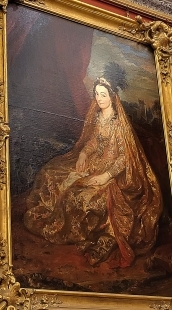A visitor from Persia in a house in Sussex
PETWORTH HOUSE IN West Sussex is a huge palace maintained by the National Trust. It contains an unbelievably remarkable collection of old master paintings, including many by Joshua Reynolds, JMW Turner, and Anthony Van Dyck (1599-1641). The paintings and many sculptures were collected by the 3rd Earl of Egremont, George O’Brien Wyndham (1751–1837), who was a patron of JMW Turner and John Constable, both of whom were regular visitors at Petworth House. When we visited the house in August (2024), we saw the paintings by Turner, but did not notice any by Constable. A full list of the paintings in Petworth is listed at: www.wikidata.org/wiki/Wikidata:WikiProject_sum_of_all_paintings/Collection/Petworth_House .
While viewing the overwhelmingly splendid artworks at Petworth, a pair of paintings by Van Dyck intrigued me. Painted in 1622, one depicts Sir Robert Shirley (1581-1628), and the other his wife Lady Theresia Shirley (1589-1668). They are fine portraits, but what interested me was the lives of these two people.

The Safavid dynasty ruled Persia from 1501 until 1736. In 1598, Robert Shirley travelled to Safavid Persia with his brother Anthony to train the Shah’s army in the military techniques used by the English army. It is not clear who put the idea of visiting Persia into the minds of the Shirleys. One suggestion is that it was mooted by the Venetians. The modernisation of the military supervised by the Shirley brothers improved the fighting ability of the Persian army to such an extent that they were able to score a great victory in a war between the Safavids and their Ottoman neighbours in 1612. After Anthony left Persia (in about 1600), Robert stayed behind with 14 other Englishmen. In 1607, he married Sampsonia, whose portrait by Van Dyck hangs in Petworth. She was a Christian lady born into the Circassian nobility of Safavid Persia. After being baptised, she added the name Teresia to her own name, and became known as Lady Teresia Sampsonia Shirley.
The Safavid Shah Abbas (ruled 1587-1629) sent Robert to England in 1608 to encourage King James I to join a confederacy against the Ottoman Empire. While in Europe, Robert visited other rulers for the same reason. Between 1609 and 1613, he lived in Spain. His wife travelled from Persia to join him there. Between 1613 and 1615, Robert was back in Persia. Then, he returned to Europe, and resided in Spain.
It was in Rome in 1622 that Van Dyck painted the portraits of Sir Robert and Lady Teresia now hanging in Petworth. They were dressed in lavish Persian clothes. It has been suggested that these ‘exotic’ outfits attracted Van Dyck, but by 1622 this couple were already sufficiently celebrated to be worthy of the artist’s attention regardless of how they were attired.
Shirley’s final visit to Persia was in 1627, when he accompanied Sir Dodmore Cotton – England’s first ambassador to Persia. However, soon after arriving there, he died in Qazvin (now in northwest Iran). His wife took his remains to Rome in 1658. She retired to a convent in that city, and lived there until her death.
I have discussed only two of the multitude of paintings at Petworth. Most of the others we saw there were not only by great masters, but also worthy of study. Although the design of the rooms in Petworth is not as spectacular as in many other stately homes, the collection within it deserves a leisurely visit. And as there is so much to see in the way of artworks, the visitor should plan to spend several hours there. We were there for three hours and that was hardly long enough.



